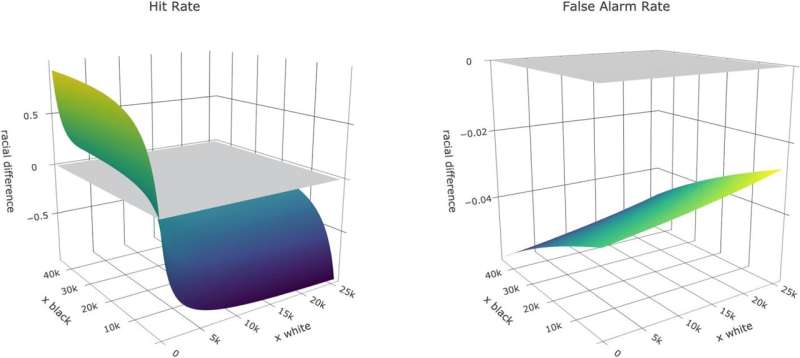This article has been reviewed according to Science X's editorial process and policies. Editors have highlighted the following attributes while ensuring the content's credibility:
fact-checked
trusted source
proofread
Study: Racial bias is no 'false alarm' in policing

Black drivers are more frequently searched during traffic stops without finding contraband than white drivers, according to a University of Michigan study.
Institute for Social Research scientists Maggie Meyer and Richard Gonzalez analyzed data from 98 million traffic stops, and showed that innocent Black drivers were likely to be searched about 3.4 to 4.5% of the time while innocent white drivers were likely to be searched about 1.9 to 2.7% of the time. The results are published in the Journal of Quantitative Criminology.
"We show that there's this pervasive bias in multiple states and multiple counties across different stop and search reasons that we need to understand," said Meyer, a doctoral candidate in psychology. "We're not the first people to find racial bias in policing and we won't be the last, but hopefully, this gives a clear place to intervene."
Meyer and Gonzalez, director of the Research Center for Group Dynamics at ISR and professor of psychology, used data from the Stanford Open Policing Project, a database of traffic stops from law enforcement agencies across the country. They examined traffic stops in 14 state police departments and 11 local law enforcement departments between the years 1999 and 2017.
Meyer says that for example, in Durham County, North Carolina, the false alarm rate for Black drivers ranges from 6 to 8% while the false alarm rate for white drivers is 3 to 4%. This equates to 11,000 Black drivers compared to about 2,500 white drivers who are searched while innocent.
"We know that there's at least this 2% difference at most, where the two values are the closest. That's where we can start to make these claims of bias," Meyer said. "The really powerful part about these data is that these findings aren't massive—they're not 30, 40%, they're 2, 3, 4, 5%. But at 98 million traffic stops across 14 states, that's still a very large and meaningful number of innocent drivers who are searched."
Officers' decisions result in tradeoffs between the probability of contraband in the population, the probability of finding contraband among those the officer selects to search, and the costs of making errors such as failing to search someone with contraband and needlessly searching someone without contraband, Gonzalez says.
The researchers had three pieces of information about these traffic stops: the total number of traffic stops during the time period in a given county or state, whether the officer searched their car, and whether they found contraband. They don't know whether drivers who weren't searched held contraband.
To account for this unknown, the researchers developed what they call the Overlapping Condition Test. They base this test on a standard descriptive tool in statistics called a 2x2 table. This table allows researchers to jointly evaluate a decision and an outcome. To do this, researchers use hit rates and false alarm rates.
In this context, hit rate is a measure of officer accuracy that depends on the contraband rate on any driver that was stopped, even if they were not searched. False alarm rates refer to the proportion of drivers officers search but do not find contraband, and it depends on the total number of innocent drivers that were stopped–even if they were not searched.
In this 2x2 table, the researchers filled in these known pieces of information: whether the officer searched and whether the officer found contraband when they searched. The researchers explored the possible values of the missing information—whether the drivers who were not searched had contraband or not.
"It's analogous to presidential elections with the electoral college. An election can be called because one candidate already has enough electoral votes to win, even though all of us haven't been counted," Gonzalez said. "So even though there may still be missing information, the outcome of the election is set. Even if those uncounted votes went for the other candidate, one candidate has already got it in the bag."
The researchers say their method can be used to inform policy to help mitigate the issue.
"We can move forward. We can say, 'Hey, there's a problem. We have to think about policy,''' Gonzalez said. "We have to figure out why officers are searching innocent Blacks more than innocent whites. We don't need to wait until we know the actual values of the missing information, because it doesn't matter what they are. The bias is there."
More information: Margaret A. Meyer et al, Detecting Bias in Traffic Searches: Examining False Searches of Innocent Drivers, Journal of Quantitative Criminology (2024). DOI: 10.1007/s10940-024-09585-4
Provided by University of Michigan




















